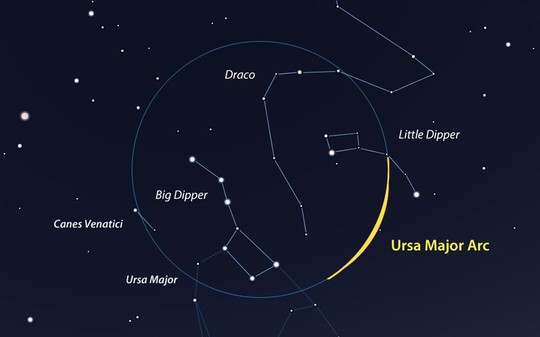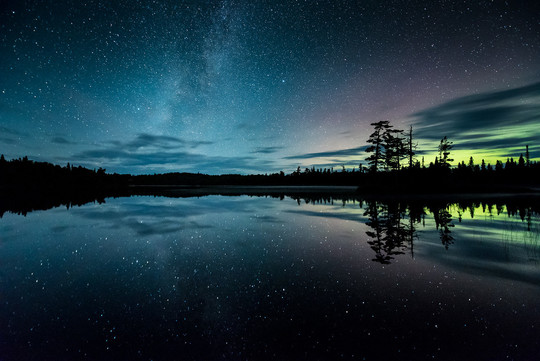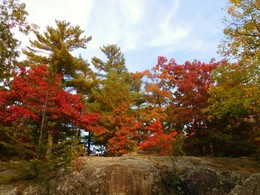 October 2020
 Stars at Temperance River State Park. PHOTO: Travis Novitsky
For some of us, the cooler temps of fall mean it's running season. For others, it's time to take a hike and observe the changing foliage up close. And for others, fall is stargazing season! Season opener? Ideal stargazing starts with the September equinox (9/22), the beginning of fall in the northern hemisphere. It's dark earlier, you can still see summer stars, catch autumn jewels, and take a first look at winter gems. This month, we get a "blue moon" to boot!
Early in September, our team was thrilled to learn the Boundary Waters Canoe Area Wilderness (BWCAW), part of the National Forest system, received the dark sky designation(*). This is only the 13th location worldwide, the largest of all... and it's right in our own backyard.
Much of the land managed by Minnesota State Parks and Trails also presents amazing opportunities for finding stars, even with a naked eye. Keep lights low and look up. Take a night hike. "Come together" with a loved one by observing the same stars from different places. Why not expand a child's curriculum with hands-on astronomy or a quick lesson in map-reading skills?
Whatever activity brings you to the great outdoors, remember: Stay healthy, six feet away from others, and be kind—always.
(*)"An IDA Dark Sky Sanctuary is public or private land that has an exceptional or distinguished quality of starry nights and a nocturnal environment that is protected for its scientific, natural, or educational value, its cultural heritage and/or public enjoyment."


Stars used to guide explorers of yore. So did compasses.
Orienteering is for all participants, regardless of age or experience. If you love hiking, trail running or walking leisurely, you'll enjoy orienteering, too.

What is orienteering?
Introduced in the late 19th century in Sweden as part of military training, orienteering consists of using a topographic map and a compass to find control flags (pictured right) in specific locations. Known as the "thinking sport" orienteering challenges both body and mind. Orienteering 101
Where?
The Minnesota Orienteering Club (MNOC.org) is reinstating meets this fall, following all COVID prevention guidelines. You can also try orienteering on your own at Afton State Park (weekdays recommended to avoid crowds) as well as at some regional parks in the Twin Cities Metro Area: Buy a map and follow the directions on the back or make your own course.
MNOC will be hosting the Orienteering USA Masters National Championships at Mille Lacs Kathio State Park Oct. 9-10, 2021. Everyone is invited to attend and participate.
|
Route Choice and Contour Game
(aka "Armchair Orienteering")
Look at the routes plotted on the map (A-E) and answer the questions below:
 From Scottish Orienteering, used with permission.
- Which orienteer(s) had the greatest amount of climb on their course?
- Which orienteer(s) had the least amount of climb?
- Which orienteer(s) had the steepest section of climb?
- Which orienteer(s) had the steepest section of descent?
- Which orienteer(s) had the shortest route?
- Which orienteer(s) had the longest route?
Visit Scottish-Orienteering.org for solution (puzzle 69) and other puzzles.
TOP
 The faces and stories of our visitors and staff.
"When I moved to Minnesota my world was flipped upside down. I never felt like I belonged anywhere, but when I'm hiking and in nature, I am home."
 Hometown: Columbus, OH, from a small, low-income neighborhood where the closest thing you came to hiking was climbing up the hill to my apartment.
My first experience in the great outdoors was in 2014, visiting North Shore parks, all the way up to the Canadian border. The more I explored, the more I fell in love with nature. I had never seen trees so tall, so many different kinds of birds, plants and wildlife. It was mind-blowing. It left me emotional and filled with longing for more.

Outdoor Adventure: Hiking! I love how high you can go on hikes and the connection you can feel with nature. You can escape the city and just breathe. You can be where the only sounds you hear are made by animals and the rustling of the leaves in the wind. I just can't get enough of it. I always cry when I have to come back to Minneapolis.
It gives me pride to even be able to walk in this freedom knowing I'm a black woman. Yes, I do get a little nervous when I see white people stare at me but I remind myself that I belong there, too. So I smile at them and keep moving.
When you're hiking you can release so many emotions—pain, regret, whatever you're feeling. Leave it all out there and escape to a world of natural beauty.
PHOTOS: Lakisha in the woods by Lake Superior (top) and at William O'Brien State Park (right.)
TOP
|

 Starry Starry Night
 Northern lights. PHOTO: Travis Novitsky
Anyone who has spent time looking at stars in the southern hemisphere might have noticed that the night sky is completely different in Minnesota. The Southern Cross (Cruz del Sur) indicates the direction of the cardinal point it is named after and can be seen south of the Equator year-round. Andromeda is visible now that it's spring in the Southern hemisphere, while we can look for Pisces this fall in the U.S.
There are officially 88 constellations in the sky spread across both hemispheres. Approximately 36 are visible from the northern hemisphere. Constellations close to the celestial equator can be seen from parts of both the northern and southern hemispheres. Interactive sky chart
But you don't have to travel to see different constellations. You can just wait for the seasonal change: Different constellations are visible in different seasons. Bimonthly star maps; constellations by time of year
 From Astro Bob article on DuluthNewsTribune.com; source: Robert Benjamin. CC-BY-SA-3.0
Same Constellation, Different Name?
Humans have been observing the universe beyond our planet for millennia, and astronomy has been relevant for many different cultures. Different constellations have different meanings and names around the world.
The Big Dipper (spoon) is called King David's Chariot, after an early king in Ireland, while in Britain it is also known as The Plough. In France they call it Great Chariot. In Ojibwe, it is called the Fisher or Ojiig. Deep Sky Objects Through an Indigenous Lens
Figures in the Sky: How cultures across the World have seen their myths and legends in the stars.
 Northern lights. PHOTO: Travis Novitsky
Stargazing At Minnesota State Parks
Today the majority of us live in urban environments, where light pollution prevents us from having the same experience of the night as our ancestors. At Minnesota state parks, outdated outdoor lighting has been or is being replaced with down-lighting and other responsible lighting systems. Thanks to that and the remote locations of our parks, you can find fantastic stargazing opportunities around the state.
Top Picks:
-
St. Croix River, by St. Croix State Park
- Great River Bluffs State Park
-
Lake Vermillion - Soudan Underground Mine State Park (Armstrong Bay)
- Buffalo River State Park
- Camden State Park
- McCarthy Beach State Park
BONUS: We hear the Milky Way looks amazing from the Rum River State Forest.
TOP

Inspired by nature, staff at Bear Head Lake State Park write poetry designed to lure you to that park. Look for their poems each week on the Fall Color Finder page, where they also report on foliage change.
 Living the best van life at Bear Head Lake State Park. PHOTO: Deb Gordon, submitted 9/22/20 via the DNR Photo Uploader.
Bear Head Lake State Park is a great place to visit, especially during this autumn season,
Visiting nature is key, and below are some examples of why, in case you need a reason.
Aspens and birch have taken over the vibrant fall explosion show,
Creating a tunnel-like canopy of bright warm yellow as you go.
Almost like a flip of a switch, the magnificent maples have lost their vivid color "pop,"
And many of the crunchy leaves are now carpeting the forest floor after their autumn drop.
The road is leaf covered, which in the rear view appears like bouncing coins behind,
Stretch your legs on Blueberry Trail as you never know what adventure you will find.
The gentle breeze will waft the distinct scent of fall, which you either recognize or do not,
A smell this ranger looks forward to and enjoys, but some say it smells of "leaf rot."
Autumn is a great time of year to walk in the pines or be on the lake,
Come visit Bear Head Lake State Park for your well-deserved break.
September 24, 2020

Peak fall colors,
are about to deliver!
from up in the hills,
to down by the river.
~Ty Gangelhoff
(Park Manager, Jay Cooke State Park)
|
TOP
|